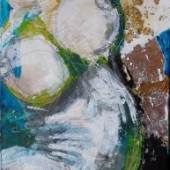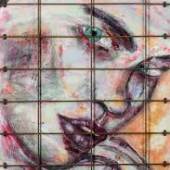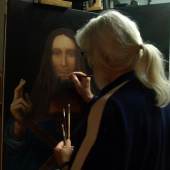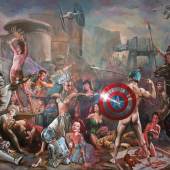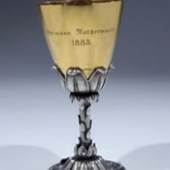Russisches Kun
Russisches Kunsthandwerk, Fabergé und Gemälde
-
Auktion29.11.2008
One highlight is a rare and treasure Fabergé-Icon called "Unexpected Joy" (Moscow, 1908-1917). It has been already auctioned in 1974 at Sotheby's New York, now it is a highlight of the exceptional offer in the Russian sale at Auction House Dr. Fischer. The icon is estimated at 18.000 Euro. Some notes to the background: On May 14th the Church venerates the icon of the Mother of God "The Unexpected Joy". In the writings of St. Dimitri of Rostov there is an instructive narrative about a certain sinner who unexpectedly experienced the joy of repentance before an icon of the Mother of God. This event became so beloved of the Russian people that an icon was drawn depicting it. The icon shows a sinner standing on his knees, praying before an icon of the Theotokos. This sinner had the habit of praying each day to the Blessed Virgin, often repeating the Archangel's greeting: "Rejoice, O Virgin full of grace!" Once, before routinely going out to sin, he turned to the holy image and fearfully saw the Holy Virgin standing live with Her Divine Son in Her arms. The Infant had wounds on His hands and feet, and blood was flowing from a wound in His side, just as it had been on the cross. The sinner fell to his knees and cried out: "O Mistress! Who did this?" "You and other sinners. Over and over again you crucify My Son by your sins, just as the Jews had done," - the Theotokos answered softly. "Have mercy upon me," - tearfully cried out the sinner. "You call Me the Mother of mercy, yet you offend Me and bring Me sorrow by your deeds." "The Unexpected Joy" "The Unexpected Joy"
"No, Mistress," - the sinner cried out in fear. - May my malice not overcome Thy indescribable kindness and mercy! Thou alone art the hope and safe haven of all sinners! Have mercy upon me, O benevolent Mother! Entreat Thy Son and my Creator on my behalf." Seeing a soul being purified by repentance, the most blessed Mother began to entreat Her Son: "My benevolent Son! For the sake of My love have mercy upon this sinner." But the Son replied to Her: "Do not be angry, My Mother, if I do not obey Thee. I, too, entreated My Father to have this cup of suffering pass Me by." Over and over the Mother of God entreated Her Son, reminding Him how She had nurtured Him at Her breast, how She had suffered at His cross. But the Lord would not bend down to mercy. Then the Mother of God arose, put Her Son down, and was ready to fall at His feet. "What dost Thou wish to do, Mother?!" - cried out the Son. "I shall remain, - She replied, - lying at Thy feet together with this sinner until Thou forgivest him his sins." Then the Son said: "The law requires a son to venerate his mother, while justice demands that the giver of the law be himself obedient to the law. I am Thy Son, Thou art My Mother; I am obliged to do Thee homage by fulfilling Thy request. Let it be asThou wishest! His sins are now forgiven for Thy sake! And as a token of forgiveness, let him press his lips to My wounds." The sinner arose, with trembling and joy kissed the most holy wounds of the Infant, and came to himself. When the vision ended, he felt within his heart both awe and joy. His soul exulted, streams of tears ran down his face. He kissed the icon, filled with gratitude for having found repentance and forgiveness, and prayed that he be granted the gift to always see his sins and repent of them. His life changed completely and remained God-pleasing to the end of his days. The icon, which so vividly embodied people's hopes for the merciful intercession and help of the Most-holy Theotokos, was always venerated highly in Russia. And even in our days Orthodox people approach the icon with a warm and heartfelt prayer, and receive comfort in sorrows and misfortunes.
Also from the private collection is an important goblet (St. Petersburg, Pavel Sasikov, 1870-1880) with a cuppa of pure gold which is engraved with a rhyme of the poem "The singer" by Johann Wolfgang von Goethe and the name and date "Hermann Rothermundt 1883". The engraved name "Hermann Rothermundt 1883" is related with the family Rothermundt in Dresden. The Rothermundts had one of the most famous and important collections of modern art including paintings of Manet, Cézanne, Monet, Renoir, van Gogh, Liebermann, Slevogt and Corinth at the beginning of the 20th century. Adolf Rothermundt was born in 1865 in St. Petersburg. His father was a merchant who became wealthy. In 1868/69 he moved to Dresden where he was in contact with the merchant Johann Meyer, who also was born in St. Petersburg. Inspired by Meyer who was a famous collector of French paintings Rothermundt presented his collection in his villa for all interested persons. This goblet with a height of 13 centimetres and a weight of 180 gram is estimated at 12.000 Euro.
Furthermore there is a rare and really fine worked Fabergé-Spoon in an original case (Moscow, Karl Fabergé, 1896-1908). The ribbed baluster shaped stem ending in the finely engraved portrait of a boyar. The portrait is very similar to two important and well known Russian works of art depicting Tsar Ivan the Terrible: the statue by Marc Antokolski which he made at the express command of Emperor Alexander II., who purchased the statue in 1870 and ordered a bronze casting of it to be placed in the Hermitage at St. Petersburg and a painting of Viktor Vasnetsov (1897), which is today in the Tretyakov Gallery. Both represent the tyrannical tsar in the same impressiv way like the spoon. It is estimated at 5.500 Euro.
There is also a select offering of modern Russian paintings: Edouard Steinberg, Vladimir Nemukhin, Vladimir Jankilewski or Il'ja Kabakov.
The sale takes place in Germany, Heilbronn on 29 November 2008. The beginning is at 3 o'clock p.m.
- << Wer zieht das große Los?
- zurück | vor
- Modernes Design und Möbel >>
